Banana Leaf Rice
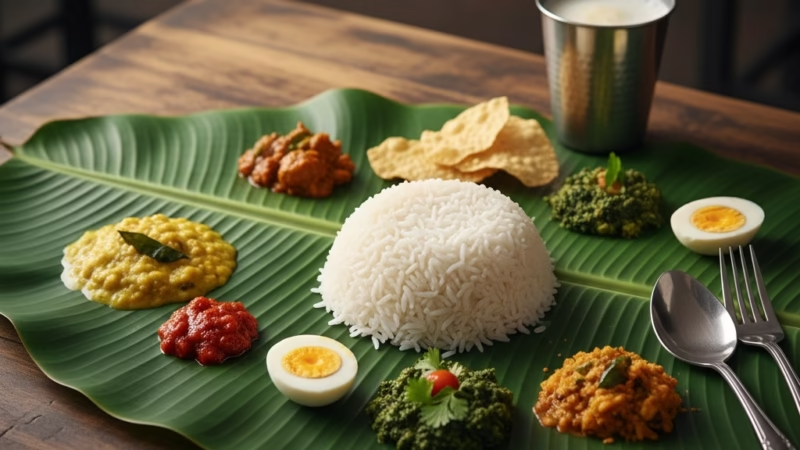
Item / Food Item:
Banana Leaf Rice
Origin:
South India (Tamil Nadu, Kerala); widely adopted in Malaysia, Singapore, and Sri Lanka.
Category:
Traditional/Staple Meal / Rice-Based Dish
Appearance:
Served on a green banana leaf; central mound of steamed rice surrounded by small portions of curries, pickles, chutneys, papadums, and fried snacks; vibrant colors from vegetables and spices.
Ingredients:
- Steamed white rice
- Sambar (lentil and vegetable curry)
- Rasam (spiced tamarind soup)
- Poriyal (stir-fried vegetables)
- Kootu (vegetables with lentils)
- Pickles and chutneys (mango, lime, coconut)
- Papadums / fried snacks
- Yogurt or curd
- Ghee (clarified butter) and tempered spices
Preparation:
- Rice is washed and steamed until fluffy.
- Curries and side dishes are prepared separately with spices, coconut, lentils, and vegetables.
- Items are arranged on a banana leaf, traditionally in a specific order.
- Hot ghee is often poured over rice before serving.
Equipment:
- Steamer or rice cooker
- Cooking pots and pans for curries
- Banana leaves (for serving)
- Ladles and spoons
Variations:
- Regional Curries: Tamil, Kerala, Karnataka versions vary in spice and ingredients.
- Vegetarian / Vegan / Non-Vegetarian: Some versions include meat, fish, or egg curries.
- Street Food Style: Simplified with fewer side dishes; popular in Malaysia and Singapore.
Taste:
- Spicy, savory, tangy, and slightly sweet
- Balanced with cooling elements like yogurt and coconut chutney
Texture:
- Soft rice, creamy curries, crunchy papadums, and tender vegetables
- Mix of smooth, crisp, and slightly fibrous elements
Aroma:
- Earthy from banana leaf
- Fragrant from curry leaves, mustard seeds, turmeric, and coriander
- Warm spices from cooked curries
Sound:
- Crunch of papadums and fried snacks when eaten
- Subtle splashing when mixing rice and curries
Cultural Significance:
- Traditionally served during festivals, weddings, and temple feasts
- Symbolizes hospitality, abundance, and community
Symbolism:
- Banana leaf represents freshness, purity, and respect for nature
- Shared meals signify unity and cultural heritage
Regional Cuisine:
- South Indian
- Malaysian Indian cuisine
- Singaporean Indian cuisine
Social Context:
- Often eaten in groups during celebrations
- Served in restaurants, roadside eateries, and temples
- Promotes communal dining and social bonding
Nutritional Information:
- High in carbohydrates (rice)
- Moderate protein (lentils and yogurt)
- Vitamins and minerals from vegetables and herbs
- Healthy fats from coconut and ghee
Health Benefits:
- Good source of fiber and plant-based protein
- Spices aid digestion
- Balanced meal with essential nutrients
- Biodegradable serving method promotes sustainability
Dietary Restrictions:
- Can be adapted for vegan diets
- Gluten-free naturally
- Non-vegetarian versions available
Allergens:
- Dairy (from yogurt, ghee)
- Coconut (in chutneys and curries)
- Mustard seeds (in tempering)
Cost:
- Affordable in street/restaurant settings
- Higher in fine-dining or specialty restaurants
Production:
- Rice is cultivated locally or imported
- Vegetables and spices sourced fresh
- Banana leaves often sourced from local farms
Sustainability:
- Eco-friendly serving (biodegradable banana leaf)
- Encourages use of seasonal vegetables
- Reduces single-use plastic/plates
Availability:
- Widely available in South Indian restaurants, Malaysian and Singaporean eateries
- Popular during festivals and cultural events
History:
- Originated in South India centuries ago
- Linked to temple offerings and festive meals
- Spread to Southeast Asia with Indian diaspora
Anecdotes:
- Eating on a banana leaf is believed to enhance flavor and digestion
- Traditionally, the leaf is disposed of respectfully after the meal
- Some stories link the meal’s layout on the leaf to symbolic representation of the universe
How to Prepare:
- Prepare rice: Wash and steam until fluffy.
- Cook curries: Prepare sambar, rasam, kootu, and poriyal separately.
- Prepare accompaniments: Make chutneys, pickles, papadums, and fried snacks.
- Assemble: Spread a clean banana leaf on a plate, place rice in the center, and arrange curries and sides around it.
- Serve: Pour ghee over rice and enjoy the meal by mixing curries with rice.
Frequently Asked Questions (FAQ) About Banana Leaf Rice
1. What is Banana Leaf Rice?
Banana Leaf Rice is a traditional South Indian meal served on a fresh banana leaf. It includes steamed rice accompanied by curries, lentils, vegetables, chutneys, pickles, and fried snacks.
2. Where did Banana Leaf Rice originate?
It originated in South India, particularly Tamil Nadu and Kerala, and later became popular in Malaysia, Singapore, and Sri Lanka through the Indian diaspora.
3. Is Banana Leaf Rice vegetarian?
Banana Leaf Rice is traditionally vegetarian, but there are non-vegetarian versions that include meat or fish curries. Vegan and gluten-free versions are also possible.
4. What are the health benefits of Banana Leaf Rice?
It is rich in fiber, plant-based proteins, vitamins, and minerals. Spices like turmeric, cumin, and curry leaves aid digestion, while the balanced mix of rice, lentils, and vegetables provides essential nutrients.
5. How is Banana Leaf Rice served?
The meal is served on a clean banana leaf, with rice in the center and curries, vegetables, pickles, and snacks arranged around it. Ghee is often poured over rice before eating.
6. Why is it served on a banana leaf?
Serving on a banana leaf is eco-friendly and biodegradable. It also imparts a subtle earthy aroma to the food and symbolizes purity, respect, and tradition.


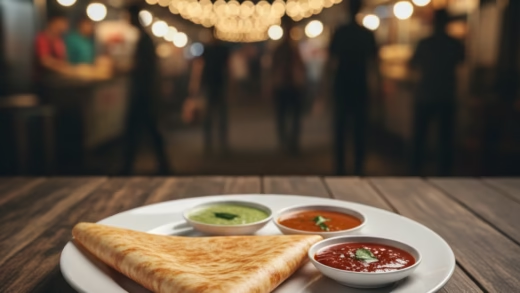
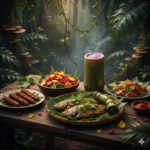


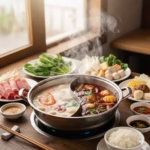
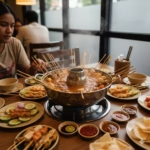
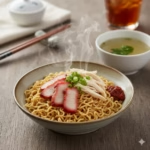

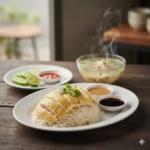
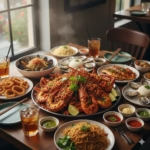
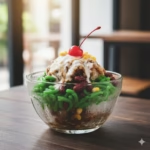


Comments are closed.